
Wuhan coronavirus: Duterte under pressure to ban Chinese tourists after Philippines confirms first infection
- Country reports first confirmed case one day after another suspected victim died in hospital
- Politicians and doctors are among those leading calls for a temporary ban on all travel to and from China
Doctors, politicians and members of the ethnic Chinese community had already been demanding the measure before a Chinese tourist visiting from Wuhan – the city at the centre of the outbreak – tested positive for the virus on Thursday.
The discovery prompted the Department of Health secretary Francisco Duque to immediately recommend a temporary ban on all travellers from Hubei province.
But some experts urged the president to go even further, with Dr Anthony Leachon, a former president of the Philippine College of Physicians, recommending a “total ban”, and the Akbayan Party Senator Risa Hontiveros demanding a 30-day ban on all air and sea travel to China and a “mandatory quarantine” period for all Chinese travellers.
China coronavirus: advice for good hygiene, from sterile Singapore
Neither has Duterte responded to Duque’s proposal. Previously, on Wednesday evening, Duterte had resisted calls for further restrictions on Chinese travellers, saying “Not yet” and reasoning that there had been no proven case of human-to-human transmission.

He was speaking just hours after the death of another Chinese man who was suspected of having the coronavirus. The 29-year-old from Yunnan, who had a history of travel to Wuhan, died after three days of confinement at Manila’s San Lazaro Hospital, a 500-bed state hospital for infectious disease. He died of pneumonia and was HIV positive, according to hospital director Dr Edmundo Lopez. Tests for the coronavirus are still underway.
How Wuhan coronavirus spread anti-Chinese racism like a disease through Asia
Last Tuesday, on the same day the Philippines stopped issuing visas on arrival to all Chinese, Singapore imposed a ban on travellers from Hubei. Authorities in the Lion City were also tracking down around 2,000 people with a history of travel to Hubei.
Malaysia has also banned visitors from Hubei province. Wuhan is the capital of Hubei.
A Philippine government official told This Week in Asia that Chinese nationals holding a Philippine work or residency visa would still be allowed to travel to and from China, even if they had a history of travel to Wuhan or Hubei.

Previously Health Secretary Duque had been reticent about implementing a total ban. On Wednesday he had warned congressmen that if the Philippines did so “China might question why we’re not doing the same for all other countries that have reported cases of the virus. It’s very tricky.”
But Dr Leachon disagreed with such reasoning. “China is the main source of the coronavirus and with the most deaths and cases globally. Protecting our people from an epidemic is paramount,” he said. “The deaths and cases are mounting – we need to do something.”
However, Philippine ambassador to China Chito Santa Romana said there was no need for a ban “because a travel ban has been imposed by China itself”.
Some local authorities have taken matters into their own hands. Cebu city has announced a 14-day quarantine period for all inbound passengers from China and the Subic Bay Metropolitan Authority barred the cruise ship M/V Dream World, which came from Hong Kong, from docking.
Taxi drivers in Manila have been refusing Chinese customers. “It’s nothing personal. I’m just afraid of getting the virus. I can’t find a face mask and they’re expensive,” one driver, Raymond, said.
Chinese schools in Manila have suspended classes until February 8 to force students – many of whom will have travelled to China over the Lunar New Year period – to quarantine themselves at home.

